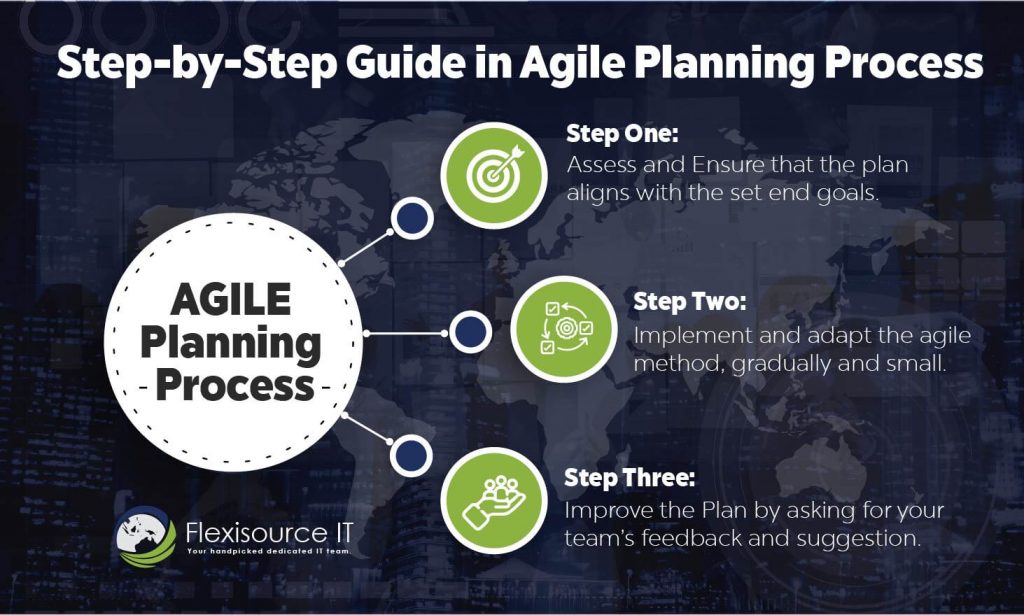Have you ever wondered how top-ranking tech companies such as Google and Microsoft were able to succeed? They can update every single product in just a week or two. Meanwhile, other companies take forever in achieving even half of their performance. If you are wondering the secret to their success, the answer is using the Agile Method.
Agile Methodology is a business philosophy constructed on fast-paced production, frequent product release, and an adequate understanding of customer feedback. Research conducted by Project Management Institute (PMI) concludes that organizations which practice agile management are more abrupt in achieving their goals. They even generate revenue 37% faster than organizations following traditional processes.
Before jumping to it, you first need to fully understand what agile Planning is and how it gives value to your business.
What is Agile Planning?
Agile Planning is a process that provides a more iterative approach than traditional project planning. It is a method of estimating work using sprints. Sprints are short periods of about one to three weeks. Within this period, teams are required to work and complete a small set of tasks. This way, businesses satisfy consumers by delivering value in a short period.
Agile Planning also should create a repeatable process that helps the team achieve what they can. A reiterative process can make a more accessible and organized process that can allow you to easily update and share iterations and move tasks to and from your product backlog.
What are the Essential Characteristics of Agile Planning?
It is essential to know the Agile Planning Principle before using the project planning method. Here are some critical characteristics that you need to have when Agile Planning:
- Agile Project Plan should be divided into sprints and quick releases. Each sprint should be 1-2 weeks, and the team has a predefined work item list called user stories.
- Agile Planning should be based on user stories. The user story should be created to the needs of your prospective users. Throughout the sprints, the team only documents the user’s needs and addresses these needs in the best possible way.
- Agile Planning needs to be iterative and gradual. All sprints need to be equal and have the same process. This process allows the team to estimate how many tasks they can finish in a given time frame.
- Team Members should do their time estimation themselves. In Agile Planning, the development team is expected to participate in Planning and assessment. The management should not “dictate” their work scope.
Step-by-Step Guide in Agile Planning Process

Step One: Assess
The first level of agile Planning. Teams need to assess and ensure that the plan aligns with the set end goals. This can help the section to focus and achieve its shared objective. The following are a few guidelines that need to be considered during this phase:
- Discuss the needed features.
These features may include tags, keywords, labels, or color-codes for managing them better and organizing them. With these features, team players better understand every task and not just their daily duties. This feature may also key out how tasks connect with the team or the business’ end goal.
- Go in-depth with the details.
Creating project details requires assessing the necessary infrastructure, the risks it entails, and other external dependencies.
- Establish a scope of work.
This step may include how much work the team should commit to finishing each sprint. It is necessary to assess this part to consider the existing tools being used and other possible work interruptions. Highlighting milestones is needed to determine how the team or the organization performs toward its goal.
- Add iteration to the plan.
An iteration or sprint, in other terms, refers to the specific period during which changes are implemented in a project. The team needs to determine the volume of backlogs they produce for the next iteration. To ensure that the project runs smoothly, the team needs to assess the performance at the end of each iteration.
Step Two: Implement/Adapt
Implementing or adapting the agile method takes massive effort. To succeed in this phase, it is advisable to start gradually and small. Successful implementation of an Agile Plan requires a changed mindset and commitment. This stage may require the following:
- Agile Coaches
To effectively implement or adapt your proposed agile plan, you need to create a group of passionate evangelists. They are the ones who will persistently assist and teach others how Agile works.
- Project Sponsorship
Project Sponsorship is vital in creating a successful agile team. Senior executives allocating resources and gaining their influence to support the team will eventually lead to a successful implementation of an Agile Plan.
- Training Programs
Imposing training programs provided by the company also greatly helps the fast implementation of agile plans. Setting training programs help empower your team into self-organization. By leading your team to self-organization, you ignite their desire to learn new things and improve their work.
Step Three: Improve
Right after the implementation of your agile plan, the demand for feedback should come next. Asking for feedback enables you to know where improvements are needed. Feedback is also necessary to inspect the team’s experience, difficulties, and progress during the implementation period. It will also affect the level of interest and commitment of team members, product users, and other stakeholders.
More about Agile:
Four Key Benefits of Using the Agile Methodology
What Agile Development Team Structure Looks Like
Five Myths of Agile Development, Debunked
As its name suggests, your agile plan can be changed and modified depending on the organization’s needs. Each organization is entitled to restructure its process that best suits its needs. They may also amend and replace specific functions to match their business operations.
What are the Key Benefits of Agile?
The key benefit of Agile is that it makes the management’s job easier and provides better control over projects. Agile Planning focuses more on value and flexibility. Similarly, Agile Planning can give the following advantages:
- Shorter delivery cycles
Agile Planning can help in shortening the delivery cycles of staff. Long delivery cycles often cause an issue in businesses, particularly those included in fast-moving markets. With Agile Planning, clients can get the return of investment (ROI) as early as possible with a short delivery cycle. Functional products are released ahead of the competition and can get more sales.
In addition, Agile Planning can also help the client determine their priority features in the most valuable order from user feedback. The client often reviews the ongoing project work for issues and changes, allowing the client to determine the priority feature and help focus on business value. With this, the team understands the essential component and goals of the client’s businesses and can deliver accordingly.
- Superior quality product
Since Agile Planning includes an iterative process, continuous learning is part of the self-organizing team. The product continuously improves as testing is an integral part of the project execution phase. This process helps to increase the overall quality of the final product. Clients often remain involved in the development process and can ask for changes, depending on the market needs.
- Improved Business Alignment
In Agile Project Management, the development team works closely with the costumes to incorporate their needs. Quality is ensured throughout the implementation phase, and all stakeholders are needed to be involved in the process with daily or weekly progress reports to address issues and share techniques.
Ensuring the quality of the product brings business alignment an essential part of project execution. Agile allows the manager to have better control over the project due to constant feedback and transparency.
- Reduced Project Cost
Agile teaches teams self-organizing skills. Having them organize their task helps the members create insight regarding what features are necessary for the product. Statistically, 45% of software features are not even used in the end products. Agile Planning spares the development team from wasting time and resources on unwanted features.
- Boost Team Morale
Since Agile teams are self-managing, members have increased autonomy and authority, giving them the freedom to make their own decisions. The plan protects the development team from micromanagement which often raises issues at the workplace.
In addition, Agile can help employees grow in their roles and learn skills by themselves, which can help the management in the long run. Collaboration is also highly encouraged in Agile, letting the team get together and discuss issues and challenges.
Agile creates an environment where teams enjoy flexible structure and independence.
Why Does Agile Planning Work?
Agile Planning is an effective method in boosting your team’s performance and productivity level. It also offers more flexibility by allowing team players to interact with each other. Furthermore, this can also be an opportunity for senior executives to collaborate with team players. Removing unnecessary activities or processes may also help the team save time and effort.
When changing your business’ tempo, it is an essential vital guide for Planning. Agile Planning is a critical guide for ensuring all phases of your business strategy are never missed. With a well-structured plan, it is easier for any business to achieve its end goal at a set time.
Flexisource IT develops quality software through fast-paced sprint iterations in Agile Development.
Interested in learning more about the Agile Project Management we can provide for your business? Download Flexisource IT’s Agile Case Study to learn more.









